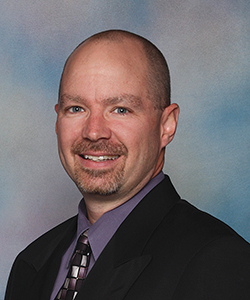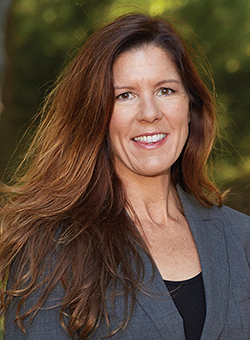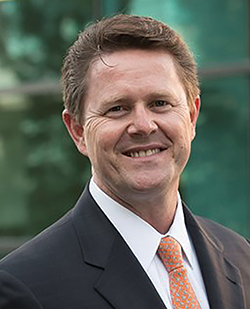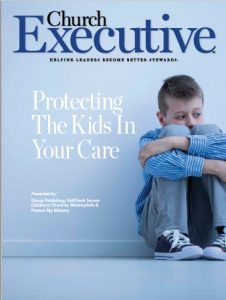
Expert advice for protecting the church’s children against sexual abuse and bullying — plus, how to mitigate internet-use risks
What are the biggest risks and liabilities facing churches in the area of protecting children?

CEO
KidCheck Secure Children’s Check-In
Alex Smith: Allegations of sexual abuse are the greatest risk
and liability.
Also, complacency — saying, ‘We’ve always done it this way,’ or ‘Bad things won’t happen here’ — that almost always ends in disaster.
Kimberlee Norris: Child sexual abuse has a devastating impact on the victim, the victim’s family, the congregation, and abuse survivors — who may be re-traumatized by news of an offender in their congregation. Child sexual abuse issues are the primary reason churches were in the courtroom over the past 15 years, and form the basis for the largest civil court judgments and settlements.
Church personnel seldom understand that molesters are grooming both children and gatekeepers — trusted adults in a child’s life — to gain access and prepare a child for abuse.

Co-founder
MinistrySafe
Failure-to-report issues are significant issue as well. Nearly 50 percent of the scenarios I encounter in my law practice — where ministries are in crisis — aren’t liability-based or likely to lead to civil ligation; they’re issues related to public perception.
Daniel Raley: The biggest risks are: failure to implement and follow a formal screening procedure and overall policy; not having a full understanding of what types of background checks should be ordered based on where the church is located, and where the applicant has lived; and not providing a structured, professionally administered Child Safety Training program on how to spot potential predators before they can offend.
Craig Cable: The single biggest risk and liability for churches is sexual abuse. Unfortunately, churches continue to be a soft target for individuals who wish to prey on their vulnerabilities.
Second are problems related to domestic issues. Whether it’s a non-custodial parent attempting to gain access to a child, or the intentional violation of a protection order for purpose of intimidating another person, churches often lack the policies, procedures and training to deal with domestic problems.
What makes churches attractive targets for potential offenders?

Co-founder
MinistrySafe
Gregory Love: Churches are heavily volunteer driven, and tend to believe that the motivations of those who want to minister to children are honorable. Staff members lack familiarity with the offender’s common grooming behaviors. As well, churches aren’t licensed. (I’m not advocating that they should be, but nearly every other child-serving context in the United States today has licensure requirements.)
Raley: Easy access to children, along with a trusting nature, make churches targets. Also, the lack of consistent screening policies, not to mention camps, overnight trips and mission trips.
Cable: First, offenders are counting on a church’s lack of consistent policies, procedures and training. Far too many ministry staff and volunteers are willing to look past best practices by adopting a flawed belief that bad things aren’t likely to occur.
This bad situation is further fueled by churches’ desperation for staff and volunteers. Too often, they’re willing to turn a blind eye to common screening practices to get a warm body in a much-needed volunteer spot.
Smith: Research shows that predators consider church leaders to be naive, or ‘soft targets.’ Predators also evaluate churches on how they deal with current situations of predatory behavior. Is there a policy in place? Are there known processes for managing predators? Are there consequences?
In your experience with churches, how many have a written child protection policy in place?

Director of Marketing
Protect My Ministry
Raley: Not enough! Especially in today’s world.
Every church needs to have and follow a written child protection policy and ensure it has a full and in-depth understanding of each element within it.
Cable: Based on conversations I’ve had with ministry leaders, I’d estimate between 30 percent and 40 percent have a formal child protection policy in place.
The biggest issue I encounter is inconsistency in the practice of policies. Churches tend to get lax with things like check-in / check-out procedures or bathroom policies.
Next is inconsistent or nonexistent training for new volunteers. You’d be surprised how many new volunteers aren’t aware of the evacuation procedures or don’t know what to do in the event of a medical emergency.
Smith: Many churches have a child protection policy but rarely refer to them, provide ongoing training, or update them to include current interest areas — social media, bullying and so on. This policy should be a living, breathing document.

Director of Church Safety and Security
Group Publishing
Fortunately, we’re seeing more child safety teams in churches — two or three people who create, define, execute, update, and train on the policy.
Norris: I have yet to encounter a church with NO policy. It’s common, however, that child-serving staff members and volunteers do not know what it says, or policy is not applied across the board. What occurs in children’s ministry, compared to the Good News Club or the Trail Life troop using the facility, is radically different.
Also, many church policies don’t address the offender’s grooming process or common grooming behaviors. The core material of MinistrySafe training describes that process and how it commonly manifests in ministry programs.
What does a truly comprehensive screening and background checks approach look like?
Cable: A truly comprehensive screening and background checks process starts with a clear strategy, including a method for determining the roles that require screening and what level of risk is associated with each role.
For example, a facilities volunteer might be adequately served with a basic background screening. Someone who serves in the children’s area needs a much more comprehensive screening, including a sex offender registry search and a county court record search. For someone who might be transporting kids, add a motor vehicle record search.
After that, a church must plan to perform re-occurring background checks annually or, at minimum, every other year.
I highly recommend performing the most comprehensive background check for anyone on staff. For volunteers, background checks can be determined based on the strategies identified above.
Smith: Screening should be role-directed, designed to act as a deterrent for would-be offenders, establish due diligence, and bubble up need-to-know information about character, commitment and prior history working with children.
Comprehensive screening includes a minimum of seven steps: a completed written application (with verifiable social security number); background check; face-to-face interview; two to three references that are checked (one being institutional, highlighting past performance working with children); a social media check (including a signed waiver); motor vehicle report (if applicable); and waiting period.
Love: Criminal background checks are not a stand-alone safety system, because less than 10 percent of sexual abusers will encounter the criminal justice system, ever. An effective screening process must include questions meant to elicit a high-risk response, conducted by screeners trained to recognize high-risk applicants. As well, a signed release authorizing the church to research the applicant’s past history by calling previous employers and past volunteer supervisors is imperative. The depth of effort and time spent looking into applicants’ past behavior should be keyed to their degree of access to children, and to what degree they’re applying for a position of trust serving children.
Raley: It’s a myth that all background checks are the same. Not only can companies do different search types, but differences in the research process and delivery of results can be extreme.

A lot of churches assume their local police search is sufficient — not true. Ninety-nine percent of the time, the information searched is only for your state. In 2015, almost 8 million people moved across state lines.
When asked where to start, we typically recommend that criminal searches be based on address history, in conjunction with an overall search (the national criminal database and sex offender registry, for example), plus ensuring you’re running the correct names and dates of birth.
A faith-based background check company understands the unique needs of a ministry and shares its values.
Some churches run different background checks for volunteers versus staff. Some also run different levels of checks based on the extent of involvement a person will have with children. However, we recommend always running the right level of screening, regardless. When you consider the costs of that method failing, it’s just not worth it. I serve in my church’s student ministry and see both staff and volunteers — across all areas — interacting with children.
Same question, here, regarding a church’s child check-in / check-out process: What elements are critical?
Smith: An effective check-in and check-out process should be more than just attendance tracking or a bolt-on feature within a larger system. It should be built on a security platform, include a mobile component or relevant app, provide access to important data, function if the internet goes down, integrate with other ChMS systems, be easy to use, and support communication with families, volunteers and staff. Features such as parent-maintained accounts which keep contact information up-to-date, identification of unauthorized (and authorized) guardians, and comprehensive reports help administrators work more efficiently and keep kids safe.
Norris: Basic security protocols — not having folks who have no business in the children’s wing, strolling through there — are totally appropriate.
In terms of child sexual abuse, however, perpetrators aren’t typically strangers; 90 percent of kids are sexually abused by someone they know and trust.
Raley: We recommend a dependable platform that’s built for the church — especially one tied into the ChMS. That way, everything is easy to reach and stay on top of.
Cable: Most importantly, it’s critical that churches have a consistent child check-in / check-out process.
Beyond that, one of the most overlooked areas is to make sure you’re prepared for the day when that process is challenged. For example, what happens when a non-custodial parent demands their child and gets verbally or even physically abusive? Does your children’s ministry team have a plan in place, and have they received training on how to navigate this incredibly volatile situation? If the answer is no, then your process might have a false sense of security.
If a registered sex offender begins attending a church, what can or should be done to help mitigate the risk posed to children?
Love: First and foremost, churches must grasp that molesters groom the gatekeepers. You can’t bring a ‘biting dog’ into a circumstance where naive congregants don’t understand what risky behavior might look like.
Before you provide services to a registered sex offender, the baseline question should be: Is this ministry fundamental to our mission? Because when you accommodate known offenders — particularly those who’ve harmed children in the past — you must do it nearly perfectly.
I’d want to see written policies and agreed limitations signed by the offender: the offender will never interact with minors, in any context.
— Reporting by RaeAnn Slaybaugh


